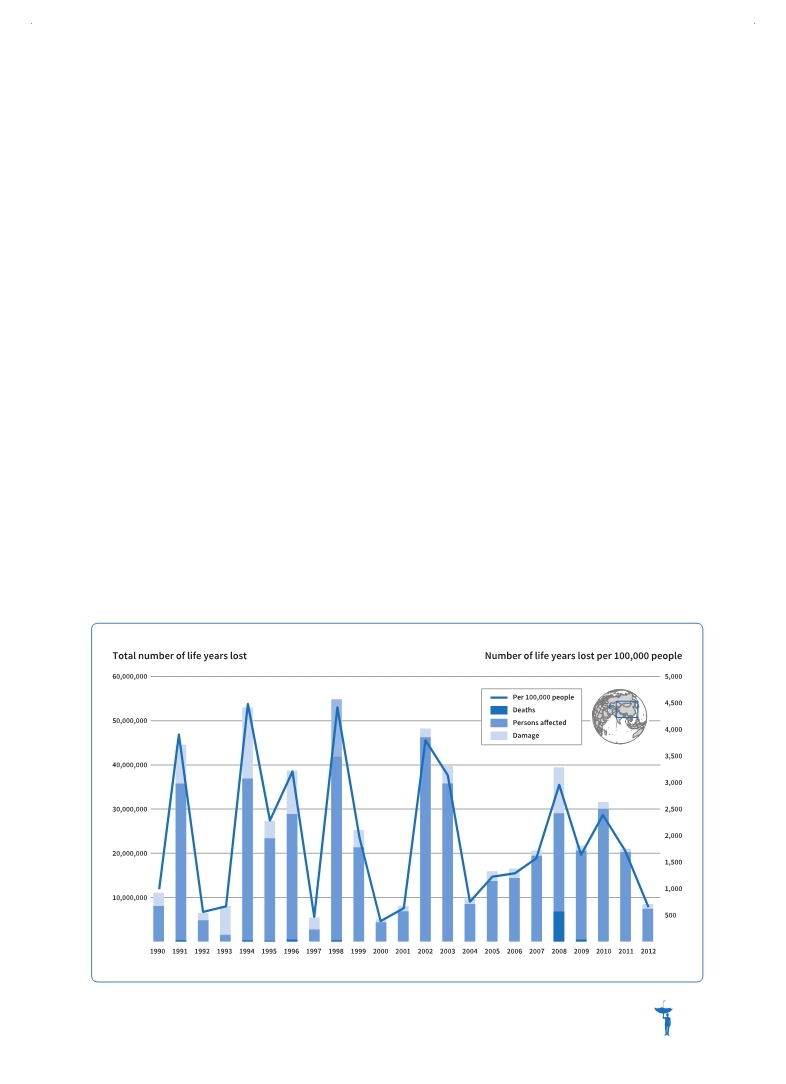 |
Global Assessment Report on Disaster Risk Reduction 2015
Making development sustainable: The future of disaster risk management |
 |
Global Assessment Report on Disaster Risk Reduction 2015
Making development sustainable: The future of disaster risk management |
|
|

41
(Source:
 Noy, 2015 Noy, 2015 Noy, Ilan. 2015,A New Non-Monetary Global Measure of the Direct Impact of Natural Disasters: country case studies, Input Paper prepared for the 2015 Global Assessment Report on Disaster Risk Reduction. Geneva, Switzerland: UNISDR.. Noy, Ilan. 2015,A New Non-Monetary Global Measure of the Direct Impact of Natural Disasters: country case studies, Input Paper prepared for the 2015 Global Assessment Report on Disaster Risk Reduction. Geneva, Switzerland: UNISDR.. Click here to view this GAR paper. Figure I.1 Loss of life years in China, 1990-2012
from malaria and about half the 90 million years lost from HIV/AIDS.5
Major disasters such as the Christchurch earthquake or the Bangkok floods in 2011 can cause a significant number of lost life years to accumulate in a single country. New Zealand lost a total of almost 200,000 life years in the February 2011 earthquake, equivalent to about 17 days per inhabitant. In Thailand, 4.76 million life years were lost in the 2011 Chao Phraya River floods; this figure translates into about 26 days per person (
 Noy, 2015 Noy, 2015 Noy, Ilan. 2015,A New Non-Monetary Global Measure of the Direct Impact of Natural Disasters: country case studies, Input Paper prepared for the 2015 Global Assessment Report on Disaster Risk Reduction. Geneva, Switzerland: UNISDR.. Noy, Ilan. 2015,A New Non-Monetary Global Measure of the Direct Impact of Natural Disasters: country case studies, Input Paper prepared for the 2015 Global Assessment Report on Disaster Risk Reduction. Geneva, Switzerland: UNISDR.. Click here to view this GAR paper. In low and middle-income countries, the losses are generally higher than in high-income countries. In China, 557,438,270 life years were lost between 1990 and 2012, which equals a per capita loss of 162 days (Figure I.1.). In Turkey, total life years lost in the same period amounted to more than 4 million, or 25 days per person (
 Noy, 2015 Noy, 2015 Noy, Ilan. 2015,A New Non-Monetary Global Measure of the Direct Impact of Natural Disasters: country case studies, Input Paper prepared for the 2015 Global Assessment Report on Disaster Risk Reduction. Geneva, Switzerland: UNISDR.. Noy, Ilan. 2015,A New Non-Monetary Global Measure of the Direct Impact of Natural Disasters: country case studies, Input Paper prepared for the 2015 Global Assessment Report on Disaster Risk Reduction. Geneva, Switzerland: UNISDR.. Click here to view this GAR paper. These figures are even higher when the loss of
life years from nationally reported disasters is included. Globally, the additional life years lost due to extensive disasters are estimated to add another 20 per cent to internationally reported disasters, and this increase can be as high as 130 per cent in low-income countries. In Indonesia, for example, when lost life years are calculated using national loss data, the total for the period from 1990 to 2012 amounts to more than 25 million life years lost, or 42 days lost per person. Small island developing states, such as the South Pacific island nation of Tuvalu, experience significantly larger per capita losses, amounting to 4 years per person since 1980 (
 Noy, 2015 Noy, 2015 Noy, Ilan. 2015,A New Non-Monetary Global Measure of the Direct Impact of Natural Disasters: country case studies, Input Paper prepared for the 2015 Global Assessment Report on Disaster Risk Reduction. Geneva, Switzerland: UNISDR.. Noy, Ilan. 2015,A New Non-Monetary Global Measure of the Direct Impact of Natural Disasters: country case studies, Input Paper prepared for the 2015 Global Assessment Report on Disaster Risk Reduction. Geneva, Switzerland: UNISDR.. Click here to view this GAR paper. As an illustration, this data underlines that disaster loss is as much a critical global challenge to economic development and social progress as disease is. However, the figures also show that it is a challenge unequally shared. Over 90 per cent of the total life years lost in disasters are spread across low and middle-income countries (Figure I.2).
|
 
Page 1Page 10Page 20Page 30Page 31Page 32Page 33Page 34Page 35Page 36Page 37Page 38Page 39Page 40Page 41Page 42->Page 43Page 44Page 45Page 46Page 47Page 48Page 49Page 50Page 51Page 52Page 53Page 54Page 55Page 60Page 70Page 80Page 90Page 100Page 110Page 120Page 130Page 140Page 150Page 160Page 170Page 180Page 190Page 200Page 210Page 220Page 230Page 240Page 250Page 260Page 270Page 280Page 290Page 300Page 310
|
|
 
|
 
|
